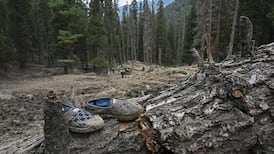The death toll in Nepal from a severe earthquake has risen to 1,341, a police spokesman has said on Saturday evening.
Of the total, more than 630 were reported dead in the Kathmandu Valley and at least 300 more in the capital.
A further 36 fatalities have been reported in northern India, 12 in Chinese Tibet and four in Bangladesh, bringing the overall total to more than 1,180.
1 of 8
Latest pics sent to ANI from Kathmandu of #earthquake aftermath pic.twitter.com/hhdXHMTQAu
— ANI (@ANI_news) April 25, 2015What an extraordinary photo, God help them! - Nepal earthquake - pic.twitter.com/POhHhWftO6
— Simon Coveney (@simoncoveney) April 25, 2015The quake, with a preliminary magnitude of 7.9, struck before noon and was most severely felt in the capital Kathmandu as well as the densely populated Kathmandu Valley.
Its epicentre was some 80km east of Nepal’s second largest city, Pokhara.
Aftershocks continued to ripple through the region for hours following the quake, the strongest to hit the country in 81 years.
A group of 11 people from Co Wexford who this week travelled to Kathmandu ahead of a visit to the base camp of Mount Everest have been accounted for after the earthquake.
Friends and family of some members of the group told The Irish Times the group were all safe but were shocked by what had transpired since they arrived in the city on Friday. They are examining the options open to them to leave the affected area.
Minister for Foreign Affairs Charlie Flanagan TD stated that his thoughts were with all those affected by the earthquake, "and in particular with the loved ones of those who have lost their lives in this tragic event. The situation on the ground in Nepal is still unfolding and my department is working through our Embassy in New Delhi to provide assistance to any Irish affected."
Emergency response team
The Department of Foreign Affairs said it had put in place an emergency response team in Dublin to handle calls from citizens or family members concerned for people they believe may be in the affected region.
The Embassy of Ireland in New Delhi, which is accredited to Nepal, is liaising with actors on the ground, including EU Member States and other international partners in Nepal, the department said.
Anyone concerned about friends or family in the region can contact the department on (01) 4780822.
Around 300,000 foreign tourists were estimated to be in various parts of Nepal for the spring trekking and climbing season in the Himalayas, and officials were overwhelmed by calls from concerned friends and relatives.
The quake occurred at a shallow depth, intensifying the amount of energy released over a relatively small area.
Houses collapsed, centuries-old temples were levelled and avalanches were triggered in the Himalayas.
One avalanche buried a part of the base camp for climbers bound for Mount Everest, killing at least 10 people, Nepal’s tourism ministry said. A further 30 people were injured by the avalanche.
“The toll could go up, it may include foreigners as well as sherpas,” tourism official Gyanendra Shrestha added.
Ang Tshering, of the Nepal Mountaineering Association, said the avalanche apparently occurred between the Khumbu Icefall, a rugged area of collapsed ice and snow, and the base camp where most climbing expeditions have their main camps.
A 19th century tower collapsed in Kathmandu when the quake struck, with local media reporting that at least 50 people had been trapped there.
The Dharara Tower, built in 1832, was a landmark that had been open to visitors for the last 10 years and had a viewing balcony.
A stump just 10 metres high was all that was left of the 14-storey structure. Several bodies were brought away from the ruins.
At the main hospital in Kathmandu, people with broken limbs and arms were being rushed in for treatment. “There are people everywhere in the corridors and out in the field,” said a Reuters reporter at the scene.
Television news footage showed people being treated on the streets outside hospitals and several bodies lying in rows, covered in blankets.
Reduced to rubble
Kathmandu is home to ancient, wooden Hindu temples. Photographs posted online showed buildings reduced to rubble, with large cracks along roads and residents sitting in the street holding babies.
The earthquake also shook several cities across northern India and was felt as far away as Lahore in Pakistan and Lhasa in Tibet - some 550km east of Kathmandu.
China’s state broadcaster said one Chinese tourist was killed at the Nepal-China border. Television reports from Bangladesh said two people were killed and about 100 injured.
Pushpa Das, a labourer, ran from the house when the first quake struck but could not escape a collapsing wall that injured his arm.
“It was very scary. The earth was moving ... I am waiting for treatment but the (hospital) staff is overwhelmed,” he said.
While the extent of the damage and the scale of the disaster are yet to be fully ascertained, the quake will likely put a huge strain on the resources of this poor country best known for Everest, the highest mountain in the world.
The economy of Nepal, a nation of 27.8 million people, is heavily dependent on tourism, principally trekking and Himalayan mountain climbing.
The US Geological Survey revised the quake’s magnitude from 7.5 to 7.9 and said the quake hit at 11.56am local time (6.11am GMT) at Lamjung.
Nepal suffered its worst recorded earthquake in 1934, which measured 8 and all but destroyed the cities of Kathmandu, Bhaktapur and Patan.
Agencies


















